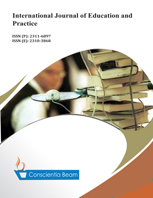Impact of Electronic Interaction Patterns in a Collaborative Learning and Instructional Anchors-Based Environment on Developing Instructional Design Skills and Achievement Motivation
DOI:
https://doi.org/10.18488/journal.61.2020.81.86.105Abstract
This study aimed to investigate the impact of electronic synchronous and asynchronous interaction patterns, in a learning environment based on collaborative learning and instructional anchors, on developing instructional design skills and achievement motivation. A quasi-experimental design was used to develop a theoretical framework and research tools, while a sample of 50 students from the College of Education at Prince Sattam bin Abdulaziz University were selected and 25 allocated to each of two experimental groups. Synchronous and asynchronous interaction patterns were used to teach instructional design skills to and stimulate achievement motivation in the first and second groups, respectively. The impact on each group was then assessed through achievement, observation card, evaluation card, and achievement motivation scale pre- and posttests. The results from the asynchronous exceeded the synchronous interaction pattern, due to its 24/7 availability, revealing the impact on enhancing students’ achievement motivation to be significant.





